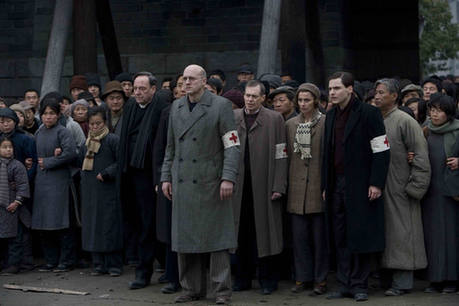By staff reporter LU RUCAI
Faces of the War
John H. D. Rabe The German businessman was working at the Siemens AG China Corporation’s Nanjing (Nanking) office when Japanese armies seized the Chinese capital on December 13, 1937. He witnessed the brutal massacre of over 300,000 Chinese civilians in the following six weeks, and recorded it in his diary.
A shot from John Rabe, a 2009 German-Chinese-French biopictorial film.

On December 14, 1937 he wrote: “It is not until we tour the city that we learn the extent of destruction. We come across corpses every 100 to 200 yards. The bodies of civilians that I examined had bullet holes in their backs. These people had been presumably fleeing and were shot from behind. The Japanese march through the city in groups of 10 to 20 soldiers and loot the shops ... I watched with my own eyes as they looted the café of our German baker Herr Kiessling. Hempel’s hotel was broken into as well, as was almost every shop on Chung Shan and Taiping Road.”
To save lives from the carnage, a group of foreign nationals founded the International Committee for the Nanking Safety Zone, and Rabe was elected chair. The committee set up 25 shelters in the city that accommodated over 200,000 refugees. Rabe opened his home to war victims, and brought in more than 600 of them. Members of the international committee worked in shifts day and night at the headquarters, guarding the shelters, fielding refugees’ complaints and providing them with food and water. Meanwhile they documented the atrocities of the Japanese occupiers.
Rabe’s wartime dairy (The Good German of Nanking in the U.K. and The Good Man of Nanking in the U.S.) was later published. It contains a raft of documents and correspondence from the International Committee for the Nanking Safety Zone, which are all marked “5 Ninghai Road,” address of the committee’s headquarters. The compound was formerly the German embassy in Nanjing. A black and white photo from 1937 shows Chinese refugees in thick winter clothes squatting or sitting in the yard, waiting for food. To protect the location from air strikes, a safety zone flag (red cross in a red circle) was unfurled across the lawn.
During his March visit to Germany Chinese President Xi Jinping mentioned Rabe, saying he is “widely respected and loved in China.” On the site of Rabe’s former residence in Nanjing – at 1 Xiaofenqiao, Gulou District, on the campus of Nanjing University – there is a memorial hall of the International Committee for the Nanking Safety Zone and a research center for international peace and conflicts dissolution. Last year the municipal government of Nanjing funded the construction of Rabe’s tomb in Berlin. As President Xi said in his speech, “In China we cherish the memory of Mr. Rabe as a man who demonstrated great compassion for life and love of peace.”
